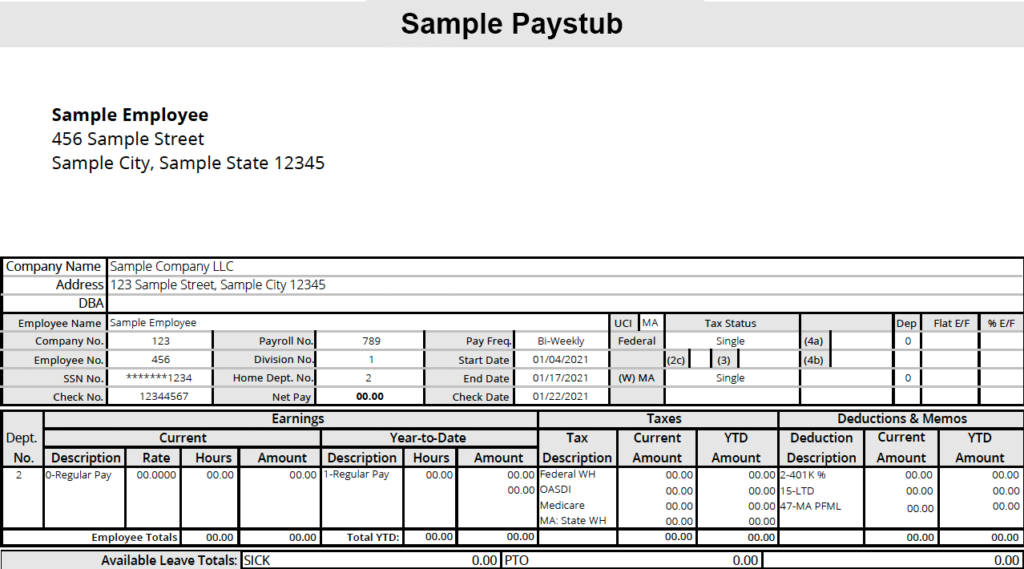Reading A Paystub: Wages, Withholdings, & More
If you are handling HR tasks, that means you’re the go-to person in the company for employee questions about the workplace. And one of the most common things workers want to know is how to understand their paystub.
From gross wages and taxes to other deductions and net pay, there’s a lot of information on each paystub that can cause confusion and even frustration. Helping employees understand their pay can go a long way to boosting their satisfaction with you as an employer.
At Complete Payroll Solutions, we have been providing outsourced payroll services to companies for over 15 years. Our payroll team members are experts in the field and trusted by more than 8,000 companies to pay employees timely and accurately. We know what’s involved in processing payroll each pay period.
To help you understand your employees’ paystubs and to help you answer their questions, this article will cover the following topics:
- What is a paystub
- Common information on a paystub
- How net pay is calculated
After reading this article, you’ll be able to help your workers understand how much they’re getting paid and feel confident that they’re being paid correctly each time.
What is a paystub?
A paystub is part of an employee’s paycheck that includes detailed information about their pay. When you pay your employees, either directly or through an outsourced payroll provider, you’ll typically provide some sort of paystub or wage statement.
If you pay your employees by paper check, then the paystub is generally attached to their paycheck. When you pay employees online, they should be able to access an electronic version of their paystub in their online portal.
Whether it’s in paper or digital format, this document gives employees a record of their earnings, helps them see what amounts are being taken out of their pay and why, and allows them to confirm they’re being paid correctly.
In addition to serving as a personal record, an employee may sometimes be required to provide a paystub in certain situations. For instance, if an employee applies for a mortgage, they may be asked to provide a paystub to show the lender that their income can cover the cost of the loan they’re requesting.
Is a paystub required?
While a paystub isn’t required federally, your state may have a law about providing a paystub or other sort of pay statement. Here are the state requirements:
Pay Statement Not Required:
Employers are not required to furnish their employees with a pay statement in:
- Alabama, Arkansas, Florida, Georgia, Louisiana, Mississippi, Ohio, South Dakota, and Tennessee
Printed or Electronic Pay Statement Required:
The following states require employers to provide a statement (printed or electronic) that identifies employees’ pay information:
- Alaska, Arizona, Idaho, Illinois, Indiana, Kansas, Kentucky, Maryland, Michigan, Missouri, Montana, Nebraska, Nevada, New Hampshire, New Jersey, New York, North Dakota, Oklahoma, Pennsylvania, Rhode Island, South Carolina, Utah, Virginia, West Virginia, Wisconsin, and Wyoming
Printed Pay Statement Required:
These states also require pay statements and the paystubs must be printed. However, electronic copies are acceptable if the employee can print the document.
- California, Colorado, Connecticut, Iowa, Maine, Massachusetts, New Mexico, North Carolina, Texas, Vermont, and Washington.
What information is on a paystub?
A paystub will typically include some or all of the following information:
- Employee name, last four digits of their Social Security number, and address
- The employer’s name and address
- The dates included in the pay period
- The rate of pay (for hourly employees, the hours worked will also be reflected)
- Gross earnings (including regular, overtime, and bonus pay)
- Accrued vacation, PTO, or sick leave in some states if you request it
- Federal, state, and local taxes withheld
- The employee’s share of FICA, a payroll tax that funds Medicare and Social Security
- Withholdings for state disability insurance benefits, where applicable
- Employee contributions to things like their 401(k)
- Deductions for benefits like health insurance or life insurance
- Any wage garnishments
- Net pay

While paystubs may vary in their exact format or design, this is generally the information employees will see each pay period. For most of the information, the paystub will include a sum for the current pay period and a year-to-date total.
What’s the difference between gross and net pay?
When reviewing their paystub, a common question employees may have is about the amount of money taken out of their pay, or the difference between their gross and net pay.
Gross wages are earnings paid to an employee before anything is taken out. To determine gross wages, it’s important to understand that they’re calculated differently depending on whether your employee is an exempt (salaried) or non-exempt (hourly) worker.
For exempt employees, their gross wages are determined by dividing their annual salary by the number of pay periods in the year. For hourly workers, simply multiply their hourly pay rate by the number of hours they worked in the pay period.
From an employee’s gross pay, any required taxes, contributions to employee benefits, and other deductions are then subtracted. For example, the amount of federal income tax withheld will be based on an employee’s Form W-4. Other deductions for things like their share of health insurance premiums or contributions to their 401(k) are determined by the employee’s plan selections.
What you’ll be left with after you subtract all of these items from the worker’s gross earnings is their net pay, often referred to as “take-home” pay. This is the amount their paycheck will be written out for or that is deposited into their bank account.
How can I ensure accurate paystubs?
Since there’s so much information on a paystub, it’s important for you to familiarize yourself with what’s included so you can answer any employee questions about their pay. You should also remind employees to review each paystub and report any irregularities or errors so you can resolve issues promptly and prevent a dispute with an employee or even IRS penalties.
Because accurate pay is so important, you may be wondering if it’s best to handle payroll in-house or outsource it to a payroll provider. We wrote a guide that will help you decide what’s best for your business by examining the pros and cons of doing payroll in-house vs. outsourcing.




